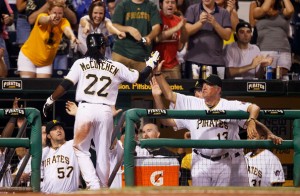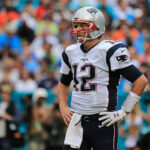Small Markets and Big Hearts

Thanks to the play of their young star Andrew McCutchen, the Pittsburgh Pirates are among the small market teams having surprise success in 2011.
Don’t look now– or perhaps you have looked— at the tables on the Sports page, but 2011 is becoming the year of the small market team. The Brewers have been climbing the standings in the NL Central, the Indians have been in and just barely out of the top of the AL Central, the Pirates have been over .500 more than they’ve been under thus far, and the Nationals (not a small market team but a small market performer) have been bobbing up and down along the .500 line.
And that’s only baseball. Oklahoma City made a run in the NBA. Buffalo had one of the best records in the second half of the last NHL season, taking Philadelphia to seven games in the playoffs. Western New York (Buffalo-Rochester) is currently dominating Women’s Professional Soccer. In men’s soccer, Real Salt Lake has emerged as a power. And of course the mother of all small market towns, Green Bay, won the mother of all American sports championships, the Super Bowl.
So what’s going on?
Perhaps there’s a lesson in what seems to be driving the US Women’s National Team in the World Cup. Despite coming into the tournament as a favorite, the US team hasn’t made the cup finals since its last victory, in 1999, and had to play in this year, after losing four matches leading up to the tournament. If you know enough about sports to be reading this, you know the story. And while the United States is anything but “small market” in almost every respect, we are certainly small market in the soccer world, despite more success in the women’s game.
The point is that after finding themselves in the unusual position of being outclassed, having to claw back from behind, the U.S. women and their phenomenal coach give credit to “heart.” When they have been outplayed they have still prevailed on heart.
The same can be said for the Pirates, Indians, Brewers, Nats, and the rest. Even the Packers. In no case do these teams have a roster on paper that justifies their achievements on the field. The common intangible is heart. It is the American tendency to overachieve, to achieve most when up against the wall, to win the biggest victory when pitted against the most daunting foe, to refuse to quit, to keep up the intensity until the final whistle.
It is this operatic quality in American sports, that presses, presses, onward until Leo Derocher’s “Fat Lady” calls down the curtain, and not until the hem of the curtain lays limp on the stage floor.
This is why championships can’t be bought, at least not in the New York’s and LA’s of the world. That is not to say that well-funded star-studded teams don’t have the will or the ability (collectively) to win when it counts, but it is to say that such teams seldom prevail when they face a smaller, more stouthearted foe.
Despite everything, sports teams in America take on the ethos of their host communities, as do their players, even their stars. And the fans in the stands channel their energy to their teams. The desperate chip-on-the-shoulder, hold your breath, scream your lungs out passion the fans bring is high octane fuel for the gladiators on the field, the court, or the rink.
Small markets also bring out the best in low-budget players, who in turn have more to prove than their Nike-sponsored colleagues. Athletes who would languish on a deep bench, or get lost, even as a starter, on a stage crowded with marquis players, find it easier, and more necessary, to rise up and play a role. The list of great players, even Hall of Famers, from small market teams who were not stand-outs before coming to the smaller market is too long to enumerate .
There are years of course when it’s all big markets all the time. But not every year, and already 2011 has been more of a small market, small team, come-from-behind year than most. I don’t know about you, but I’m having a great time watching it all unfold.
John Wingspread Howell is a novelist, writer (about sports and life) and entrepreneur originally from, and now back home again in Buffalo, New York. http://johnwingspreadhowell.com











